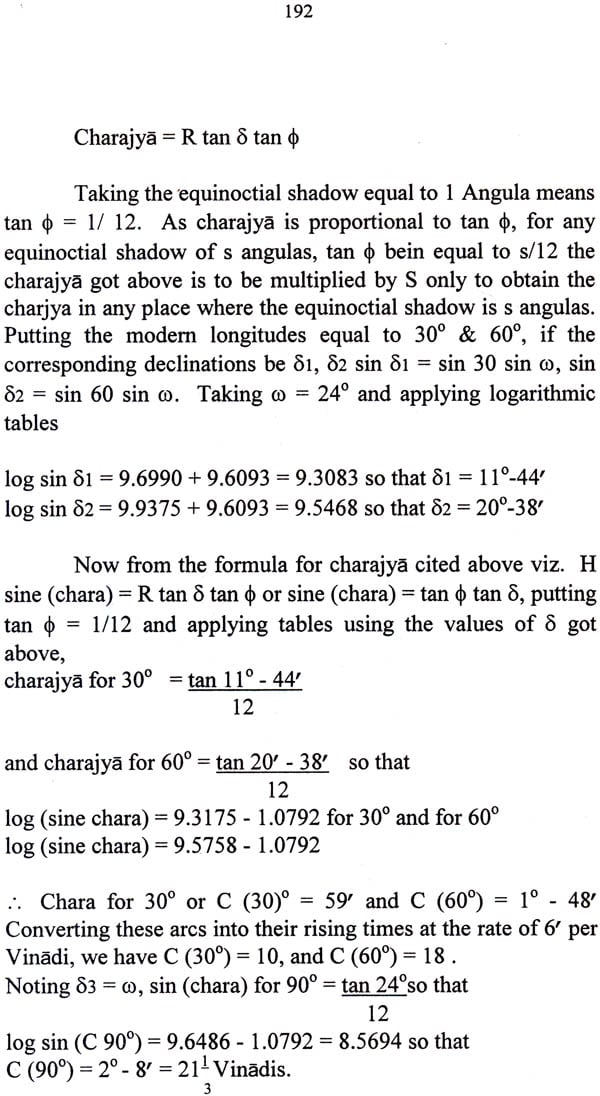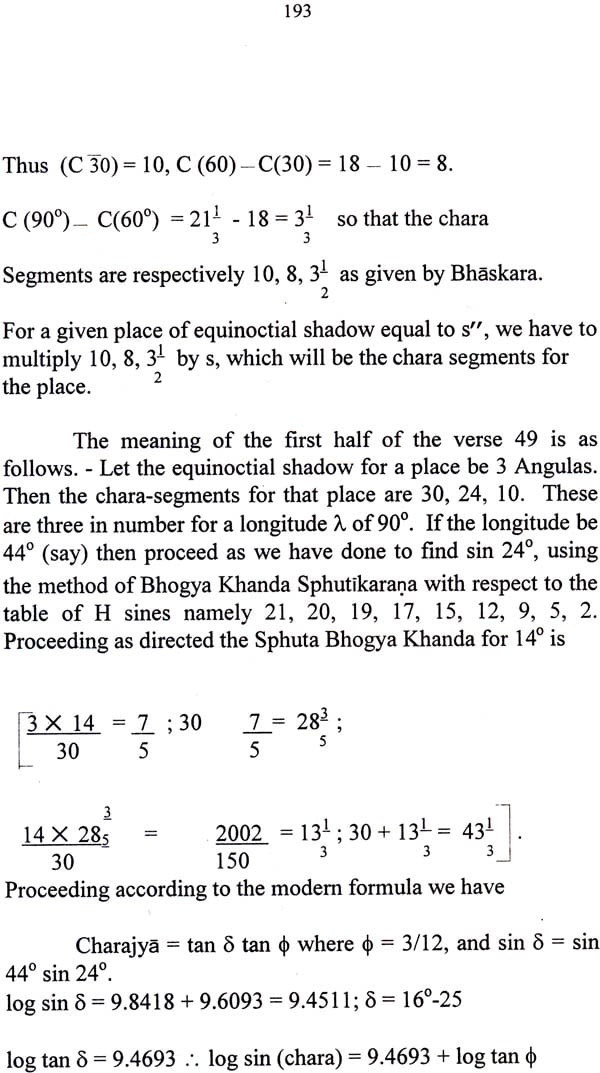
Siddhantasiromani of Bhaskaracarya (English Exposition and Annotation in the light and language of modern Astronomy along with original text in Sanskrit)
Book Specification
| Item Code: | IDK308 |
| Author: | Dr. D. Arkasomayaji |
| Publisher: | Rashtriya Sanskrit Vidyapeetha, Tirupati |
| Edition: | 2000 |
| Pages: | 720 |
| Cover: | Hardcover |
| Other Details | 9.4" X 6.5" |
Book Description
Preface
It is a matter of great satisfaction and pride that keeping with its tradition the Rashtriya Sanskrit Vidyapeetha, Tirupati, has been able to bring out the revised edition of the English Exposition and Annotation of Jyotisha text, the Siddhantasiromani of Bhaskaracharya, one of the renowned astronomers that the medival India produced. The English Exposition and Annotation was authored by Dr. Arka Somayaji an erudite scholar in Jyotisha, who served this Institution with dedication for several years. Since the first edition of this work contained only the English Exposition and Annotation, it was felt that it will be more useful if the original text is also added. Hence the present edition contains the original Sanskrit work.
I am sure that the students and as well the scholars of Astronomy will equally be benefited by the present edition.
I shall take this opportunity to express sincere thanks to Prof. S.B. Raghunathacharya, former Vice-Chancellor of this Vidyapeetha, who during his tenure took the initiative to bring out this edition. I also thanks the members of the staff of the Research Department of this Vidyapeetha without the best efforts of whom the present edition would not have come so superbly.
Publisher's Note
The Vidyapeetha has been publishing a number of books on Veda and Sastra subjects over the past 30 years. The English Exposition and Annotation in the light and language of modern Astronomy on Siddhantasiromani of Bhaskaracharya by the illustrious scholar Dr. Arka Somayaji ws published by the Vidyapeetha in 1980. The book has earned the appreciation of the scholars of repute in the field of Jyotisha.
Dr. Arka Somayaji was born in a traditional Vedic scholars' family. He was a great scholar in Sanskrit, Srouta Sutras, Astronomy and Mathematics. Besides his traditional background Dr. Somayaji had a modern outlook on the dissemination of Veda and Sastra knowledge. He authored many works.
The Siddhantasiromani, now being published, is a revised edition of the first print by Dr. Somayaji. The very fact that the copies of the book were sold out in a very short time and that it has been in constant demand, itself speak volumes of the great scholarship and the authority on the subject of the editor.
Keeping in view the great demand for the precious book the Vidyapeetha decided to reprint it. It is a matter of great pleasure that the task could be completed in a short time. It is earnestly hoped that the revised print of the Siddhantasiromani will be received with appreciation by the scholarly world.
From the Mathematician's point of View, Bhaskaracarya's Siddhanta Siromani contains all that was beautiful in the Ancient Hindu Astronomy. I am aware that a translation of this work into English was done long ago by M.M. Bapudeva Sastry and Wilkinson; but I did not have the good fortune of having a copy in my hands all these years. I did go through the translation once long ago, but it gave me the impression that all the beauties there that appeal to a Mathematician were not brought out fully. There are, however, a good number of Sanskrit commentaries both ancient and modem but even they, in my humble opinion, have not done full justice to the elucidation of Bhaskara's mathematical genius. Further misinterpretations are not infrequent in some of those books, as will be pointed out in the course of this book.
What has sponsored me to undertake to write an English commentary, (I may add that a Sanskrit commentary also has been written by me on this work and has been awaiting printing) is essentially that innumerable modem professors of Mathematics complain many a time that there is no such a presentation of Siddhanta Siromani in English as will enable them to assess the Mathematical content of it in the light and language of modern Astronomy. Hence, I have sought to produce a fresh commentary, which I hope will meet the desire of such professors and students of Mathematics. I may add here that this work of mine seeks to present only the Mathematical side of Siddhanta Siromani. It is no history of Hindu Astronomy, where the originality of the Ancient Hindu Astronomers is sought to be evaluated. I may confess that I am no historian.
In the course of this book, I shall have occasion to quote from most of the Astronomers of ancient India like Aryabhata I, Varahamihira, Lalla, Aryabhata II, Brahmagupta, Bhaskara I, Munjala, Vatesvara and Sripati not to speak of some others, whose books are available in print or manuscript.
One thought that lurks in my mind, I make bold to present in this preface. I say 'I make bold' because, there are some historians of Hindu Astronomy, who are too ready to attack me if I claim that there must have been not a primitive astronomical activity in ancient India prior to Aryabhata I. The reason for their attack is that prior to Aryabhata's work, only one crude Vedanga Jyotisa has come to light. Also some of these historians have a strong impression that the galaxy of Hindu Astronomers ranging from Aryabhata derived an incentive from a foreign source especially the Greek. If such historians agree to keep an open mind, I make bold to present my thought as follows. In my humble opinion there must have been considerable astronomical activity in ancient India even prior to Aryabhata. This is borne out by the following expressions of Aryabhata and others. Aryabhata says 1 that he dived into the then extant astronomical lore, which got mixed up with mathematical and non-mathematical (mythological or otherwise) knowledge, and by his intellect and the grace of his Goddess, broughtout the truly mathematical. Varahamihira2 says that he was codifying the then extant five Siddhantas, out of which the 'Savitra' was more accurate. Brahmagupta ' says, again, that he was giving a clear presentation of the ancient Brahma Siddhanta which got obsolete by a long lapse of time. In the wake of these statements and a number of others, is it not right to construe that there did exist some ancient astronomical texts which are lost to us. If, as asserted by a host of modern interpreters, we think that there was only the crude Vedangajyotisa, before Aryabhata, does it not tantamount to saying that these three great astronomers (leave others) were impostors, who, having derived their knowledge from a foreign source, simply claimed that there were existent before them, Saura Brahma and some other Siddhantas which dealt with Graha-ganita. It is uncharitable to say that three rational astronomers were such impostors. So, we must conclude that there did exist some astronomical activity, which we have no right to call primitive like the Vedangajyotisa. Some might think that there might be existing some other texts in between the times of Vedangajyotisa and Aryabhata but that at the time of the Vedangajyotisa" (roughly 1180 B.C) astronomy in India was that crude. Even this conclusion need not be correct, for the simple reason that, even today, crude works exist side by side with advanced works. The simple fact that a Vedangajyotisa belonging to 1180 B.C. has been unearthed and nothing else, is not a complete proof that there did not exist more advanced texts some where else in such a big country like India especially when locomotion or transport was difficult.
Just one more thought, I place before the learned historians, which is pertinent to this context. According to geology, biology and some other similar modem sciences, the first man carne into the cosmic picture some millions of years ago. If that be so, how is it that we say that man remained stupid all these years and happened suddenly to blossom into a genuis one morning round about Eighteen fifties (1850 A.D.) whereafter carne all Scientific discoveries in a series, as if by the waving of a magic wand? It could not be so, as if, we are the chosen few of God. Civilizations must have been there, which got buried in the bosom of the earth, as has been revealed by the Mohenzadaro excavations. Hence we are not right in saying that the ancient Hindu civilization was so primitive at 1150 B.C. as is reflected in the Vedanga Jyotisa. This is another and more important reason that this author makes bold to place before the historians as to why he (the author) does have faith in the statements of Aryabhata, Varahamihira and Brahrnagupta who said that they were peacing out the knowledge contained in the then extant works signifying at the same time that many more books were lost even to them.
In this commentary of mine, I have chosen to keep the commentary away from the Sanskrit text and Bhaskara' sown Vasana Bhasya, for, otherwise the book grows bulkily unwieldy. I have chosen to keep silent over passages which do not call for a mathematical elucidation. Here and there I have chosen to present what modem astronomy presents in some particular contexts, so that, mathematics students who do not happen to study modem astronomy may have a better perspective of the ancient Hindu astronomy, presented in Juxtaposition to the corresponding modem treatment.
However, I do not propose to enter into the intricacies of modern astronomy which are not called for to elucidate the text.
Before concluding, it is my sacred duty to thank the Rastriya Sanskrit Samsthan, under the Ministry of Education, Social Welfare and Culture, Government of India, for having accepted my work under the publication series of K.S. Vidyapeetha, Tirupati and the latelamented Dr.M. Ananthasayanam Ayyangar, former Chairman of KSV and Ex- Governor of Bihar, who encouraged me in my studies on Hindu Astronomy. Dr. M.D. Balasubrahmanyam deserves my thanks for the encouraging interest he has shown in the publication of this annotation.
| Foreword | xv | |
| Preface | xix | |
| 1 | Siddhantashiromanou Ganitadhyaye Madhyadhikare | 1 |
| 2 | Madhyadhikara | |
| Section II Bhaganadhyaya | 19 | |
| 3 | Grahanayanadhyaya | 30 |
| 4 | Madhyadhikara-Kaksadhyaya | 48 |
| 5 | The Adhyaya known as Pratyabda Suddhi in Madhyadhikara | 58 |
| 6 | The Section known as Adhimasadinirnaya in Ch. I | 76 |
| 7 | The Section Bhu-Paridhi Manadhikara Circumference of the Earth | 89 |
| 8 | Spastadhikara-Rectification of Planets | 108 |
| 9 | The Triprasnadhikara | 238 |
| 10 | Parvasambhavadhikara | 354 |
| 11 | Lunar Eclipses | 369 |
| 12 | Grahacchayadhikara | 475 |
| 13 | Grahodayastadhikara | 498 |
| 14 | Srngonnatyadhikara | 509 |
| 15 | Grahayutyadhikara | 529 |
| 16 | Patadhyaya | 550 |
| Appendix | 574 |







